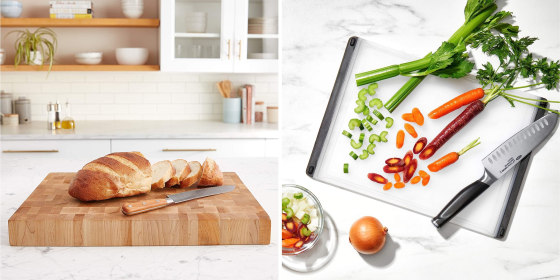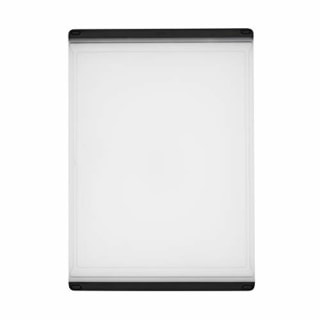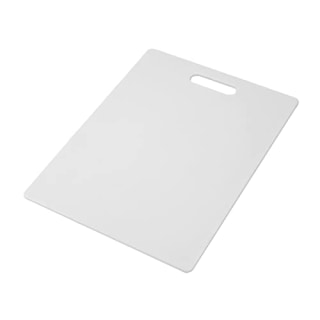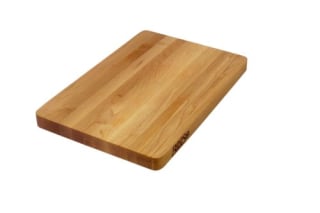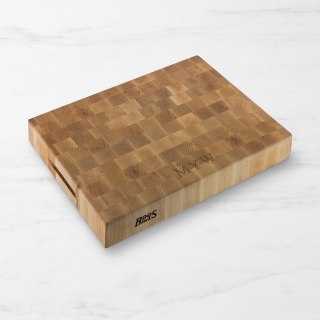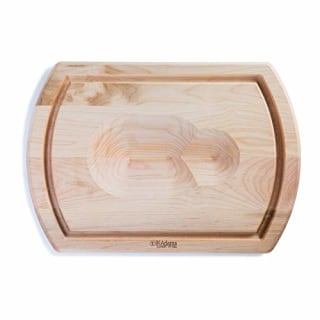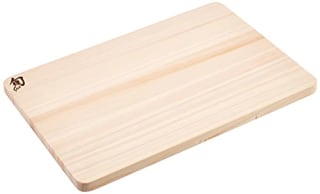Material: Polypropylene plastic | Dimensions: 14.75 x 10.5 x .5 inches | Weight: 1.5 pounds | Dishwasher Safe: Yes
Farberware Large Cutting Board
Polypropylene plastic cutting boards are great for anyone on a budget and those who want dishwasher-safe boards according to our experts. If those are your priorities, you cannot beat the price of this lightweight, no-frills board, which has a 4.6-average star rating from more than 13,000 Amazon reviews. It has a large hole on one side for gripping, plus the poly material is nonabsorbent and gentle on your knives, according to the brand.
Material: Polypropylene plastic | Max Dimensions: 11 x 14 x .5 inches | Weight: 1.1 pounds | Dishwasher Safe: Yes
John Boos Maple Cutting Board
Both Elliot and Jessie Riley, a food safety instructor and an adjunct professor in the Department of Hospitality Management of New York City College of Technology, recommend John Boos for quality cutting boards that will last. In our experience, this all-purpose, maple board yields slightly under your knife as you cut making it comfortable to work on and easy on knife blades. At 5 pounds, the 1-inch thick board is slightly hefty, but still light enough to comfortably carry around your kitchen. Like other options on our list, it’s available in multiple sizes.
Material: Maple wood | Dimensions: 16 x 10 x 1 inches | Weight: 5 pounds | Dishwasher Safe: No
John Boos Block Maple Chopping Block
This rectangular, reversible wooden cutting board from John Boos will “last forever,” says Riley. It has recessed finger grips in the sides to make it easier to lift, though at 21 pounds, it is not light. Made of end-grain maple, it’s exceptionally gentle on knife blades, according to Riley. Plus, its checkerboard pattern makes for a great addition to any countertop. Like other wooden boards, you’ll need to hand wash, dry it and apply oil (especially in dry climates) as needed. Since the board is 2 ¼-inch thick, you may have an adjustment period when using it if you’re not used to cutting on a high surface. Smaller and larger versions are available as well.
Material: Maple wood | Dimensions: 20 x 15 x 2.25 inches | Weight: 21 pounds | Dishwasher Safe: No
J. K. Adams Maple Reversible Carving Board
When it comes to carving a chicken or a roast, O’Rourke recommends a wooden carving board with an indentation in the middle to hold the meat in place, and a trough to catch the juices. This maple board is also reversible. On one side it has a hollow for your bird to sit steadily as you slice, along with a channel that can hold about ½ cup of drippings; the other side, which is flat and has a wider trough, is intended for general slicing and dicing.
Material: Maple wood | Dimensions: 20 x 14 x 1 inches | Weight: 6.5 pounds | Dishwasher Safe: No
JosephJoseph Folio Icon 4-Piece Cutting Board Set
Elliot, O’Rourke and Riley all say it’s a good idea to use boards of a different color for different purposes to prevent cross contamination — especially if you cut up a lot of raw meat, poultry and seafood. In this set, you get four lightweight boards; each is a distinct color and has an icon indicating which food you should use it for: green for produce, red for raw meat, blue for seafood and white for cooked food. Little feet on the ends of both sides help the boards stay securely in place as you cut. Plus, the boards come with a slim storage case that can sit neatly on the side or at the back of a countertop. They don’t sit tightly together in the case, so there’s room for air to circulate between them, according to the brand. (This helps prevent mold or mildew from developing.) You can also purchase an identical smaller set.
Material: Polypropylene plastic | Case Dimensions: 14 x 10.25 x 3 inches | Board Dimensions: 13.4 x 9.5 x .5 inch | Set Weight: 5 pounds | Board Weight: .75 pound | Dishwasher Safe: Yes
Shun Large Hinoki Cutting Board
The ultimate material for a cutting board is hinoki (Japanese cypress) because it has very strong antibacterial properties, which is why sushi chefs often use it, according to Bob Kramer, a master bladesmith and owner of Kramer Knives. Hinoki is a medium-soft wood that gives a little as you cut, making it comfortable to work on and very easy on knife blades, according to Kramer. Before using it, wet the surface of the board to help it resist staining. Like most cutting boards, it will develop marks from knife work over time — so don’t be alarmed if you see etches as you chop. It’s also available in both medium and small sizes too.
Material: Hinoki wood | Max Dimensions: 17.75 x 11.75 x .75 inches | Weight: 2.7 pounds | Dishwasher Safe: No
How to shop for cutting boards
Before purchasing a cutting board, consider the following:
Material
Most of our experts prefer wood because of the way it feels under their knives as they cut, plus it’s the gentlest on blades and the least likely to dull knives quickly. However, they also recommend polypropylene plastic boards, which are soft enough to keep knives from slipping and will be only marginally harder on the edges. All of our experts say they keep a plastic board in the kitchen for tasks like dicing raw tuna for poke, slicing a rare steak or deboning chicken breasts because they can easily clean and sanitize it to remove bacteria.
When it comes to preventing bacteria, wood also has its benefits: it’s naturally antimicrobial and more porous, so meat and poultry juices don’t remain on the surface and drip down into the wood, where they are killed, according to Riley. On a plastic board, drippings remain on the surface and can be hiding in microscopic grooves on the board.
Avoid cutting boards made of glass, ceramic or marble because they’ll wreck your knives, says Riley. Cutting boards that are made of a paper composite are also very hard on blades and you should avoid them for anything besides serving and displaying food.
Wood variations
Wood cutting boards come in end-grain and edge-grain variations. You can recognize end-grain cutting boards by their checkerboard pattern. They’re constructed of short pieces of wood glued together that have the cut ends facing up. Picture it as looking down into the top off a box of spaghetti, says Elliot.
This type is the easiest on a knife blade because the knife slices between the wood fibers rather than making contact with a flat surface. It is also less likely to show scars from cutting. However, end-grain boards are more difficult to manufacture and therefore considerably pricier. Plus, because so many pieces are glued together, they can come apart if the board is not well made or soaked in water for more than a few minutes. Edge-grain boards on the other hand, are made from parallel strips of wood and are much more durable and common, and are easier on your budget.
Size
A cutting board should give you plenty of room to cut. You don’t want to feel cramped as you work or run out of space. (One example of this is having to stop frequently to transfer your sliced, chopped or minced ingredients to a bowl or pot.) Riley suggests buying a board that is roughly the width from one of your shoulders to the other. Look for a board that is at least ½-inch thick. The thicker the board, the more stable it will be and the less likely to warp; thin flexible plastic mats are good in a pinch, but not for serious prep work.
Before buying a board, you should be sure it will fit in your sink or in the dishwasher (if it’s safe for machine washing), according to Riley.
If you cook and entertain often, it’s a good idea to have boards in a variety of sizes, including a large one for carving and smaller ones for slicing lemons at the bar, according to O’Rourke.
How to use your cutting board safely
Keeping a board stable is essential to safety, says O’Rourke. Unless your board has feet or suction grips that prevent it from moving, you want to place something (like a wet paper towel or dish towel) under the board to anchor it. If you’re looking for something fancier, O’Rourke uses a silicone pad while Eliott, Kramer, and Riley all recommend a piece of textured, reusable shelf liner that you do not need to wet and won’t build up mold if you forget about it.
You should also make sure your knives are sharp. A dull blade not only makes knife work more difficult, but it also makes it more dangerous as the blade can slip sideways on the cutting board and cut your finger.
How to clean your cutting board
How you clean your cutting board will depend on the material of your board. Below, we’re sharing our experts’ recommendations on cleaning best practices:
- Plastic: Unless the manufacturer specifically recommends against it, you can use a dishwasher. If you’ve used it to cut raw meat, poultry or seafood, use the sanitizing cycle. If you prefer to wash your boards by hand or don’t have a sanitizing cycle, follow the instructions for wood.
- Wood: Wash thoroughly by hand with dishwashing detergent and hot water, then rinse and dry. If you have any stuck-on bits or minced a smelly food like garlic, scrub that area with a mixture of kosher salt and lemon juice or white vinegar. After using raw meat, chicken or fish, flood the surface or soak your board (as well as your knife) in a solution of 1 tablespoon bleach to a gallon of water for 10 minutes.
When wood feels dry to the touch or “thirsty” as Kramer says, condition it with food-safe mineral oil or coconut oil. Do not use any cooking oil like olive oil that can go rancid. If a board develops deep grooves or crevices that can harbor bacteria, it’s best to replace it.
Meet our experts
At Select, we work with experts who have specialized knowledge and authority based on relevant training and/or experience. We also take steps to ensure all expert advice and recommendations are made independently and without undisclosed financial conflicts of interest.
- Jeffrey Elliott is the author of "The Complete Book of Knife Skills".
- Bob Kramer is a master bladesmith.
- Suzen (Suzi) O’Rourke, is the founder of Cooking by the Book, which offers hands-on culinary experiences for corporate team building and private events.
- Jessie Riley, is an adjunct professor in the Department of Hospitality Management of New York City College of Technology. She is a ServSafe certified instructor for food handlers, food managers, alcohol, allergens and workplace safety and also holds a New York City certification for food handlers.
Why trust Select?
Sharon Franke is a freelance journalist who specializes in kitchen equipment. For over 30 years, she worked at the Good Housekeeping Institute where she was Director of the Kitchen Appliances Lab. She has extensive experience testing cutting boards in a lab and using them in her own home kitchen. For this story she spoke to four experts, including two cooking instructors, a cookbook author and a knife maker. Sharon also researched dozens of highly rated cutting boards online.
Catch up on Select’s in-depth coverage of personal finance, tech and tools, wellness and more, and follow us on Facebook, Instagram, Twitter and TikTok to stay up to date.
